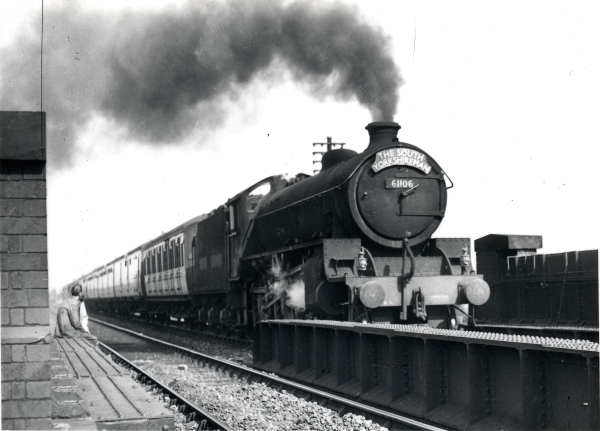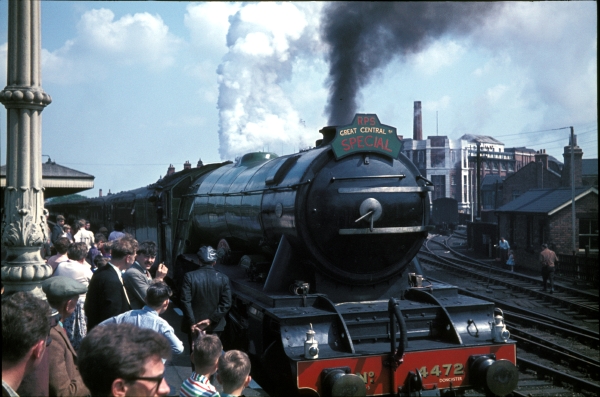The end of the war in 1945 also saw a Labour government come to power and with it came the proposal for nationalisation. The idea had been around since the end of the 19th Century, but only now did the cogs begin to turn to get the process underway. The Transport Act was passed in 1947 and the railways, along with virtually all public transport systems, were brought together under the control of the new British Transport Commission. The idea behind the scheme was to integrate the public transport of the British Isles into one public service, and once again, a new corporate identity was required. Before long, locomotives began to appear bearing the legend, BRITISH RAILWAYS, on their tanks or tenders instead of the familiar LNER. Once again, it was "All change" at Leicester Central.
British Railways (ex-LNER) B1 class 4-6-0, No. 61106, pictured hauling 'THE SOUTH YORKSHIREMAN' on the approach to Leicester Central Station, circa 1955. Note the man casually sitting on one of the bridge girders, and the wording "BRITISH RAILWAYS" on the locomotive's tender. See Details
Under British Railways, the national rail network was divided into six operating 'Regions' that were loosely based on the old Big Four companies' systems. The southern part of the old LNER became the Eastern Region, and it was into this area that the London Extension fell. Each Region had its own colour scheme - the Eastern's being dark blue - and new station signs and notice boards soon appeared at Leicester Central in this new corporate livery. This regional colour scheme did not stretch to locomotives and rolling stock (although the Southern Region managed to retain the old Southern Railway carriage livery of malachite green), and the apple green of the former LNER 'top link' locomotives was replaced with a deep Brunswick green. Freight locomotives remained black as they had under the LNER and the Great Central before them.
Ex-LNER A4 class 4-6-2, 60014 - SILVER LINK at Marylebone. See Details
Control of the London Extension passed from the Eastern Region to the London Midland region in 1958, thus starting the line's decline and fall. To the new management, the old Great Central route was something of an anomaly and was seen as being surplus to requirements. Slowly but surely, the route's fleet of steam locomotives was replaced by old and worn out machines, and the line's services were gradually cut back in line with the suggestions in the Dr. Beeching report. The first to go were the stopping services at the local village stations in 1963/64, and this was followed by the removal of freight services in June 1965. Leicester Central was badly hit by these curtailments as the parcel service had operated from the station. Staff were laid off or transferred elsewhere, and the station's sidings were lifted. Yet it was still not the end.
On 15 June, 1963, Leicester Central Station was honoured with a visit from the world famous locomotive, No. 4472 - FLYING SCOTSMAN. In the run down to the end of steam, rail tours such as this became increasingly popular, with many running over the old GCR route. In the dying days of Midland Region operation, a sight like this was very welcome. See Details










